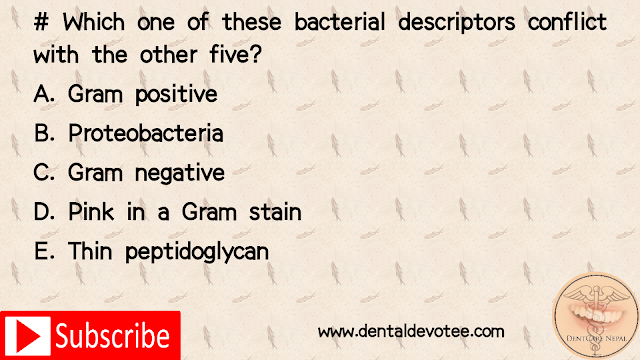# Which of the following organisms is an intracellular parasite?
A. Nocardia asteroides
B. Coccidioides immitis
C. Histoplasma capsulatum
D. Aspergillus flavus
E. Cryptococcus neoformans
The correct answer is C. Histoplasma capsulatum.
Histoplasma capsulatum is a type of fungi
which is the main cause of histoplasmosis
infection. This is an intracelular parasite of
macrophages that commonly causes
fungal respiratory infection in the US.
SEARCH:
Acute arthritis of the great (big) toe is a diagnostic sign
# Acute arthritis of the great (big) toe is a diagnostic sign of which of the following diseases?
A. Osteoarthritis
B. Osteomyelitis
C. Gout
D. Osteoporosis
E. Rheumatoid arthritis
A. Osteoarthritis
B. Osteomyelitis
C. Gout
D. Osteoporosis
E. Rheumatoid arthritis
The correct answer is C. Gout.
The acute arthritis of the big toe is a
pathognomonic sign of Podagra or Gout.
What distinguishes Gout from others is that,
it usually occurs in one of the joints in the
body, however, about 50% are said to occur
in the big toe. This disease is also referred
to as "disease of the kings" or "the rich
man's disease".
Chemotherapy for Leukemia
# A patient receiving chemotherapy for leukemia is highly susceptible to develop which oral infection?
A. Candidiasis
B. Actinomycosis
C Histoplasmosis
D. Coccidioidomycosis
E. Blastomycosis
A. Candidiasis
B. Actinomycosis
C Histoplasmosis
D. Coccidioidomycosis
E. Blastomycosis
The correct answer is A. Candidiasis.
Immunocompromised patients are more susceptible to candidiasis, the fungal infection caused by Candida albicans. A patient with leukemia has lower than normal functioning leukocytes. This, coupled with chemotherapy which aims to
reduce the number of abnormal leukocytees, leaves the patient in a very
immunosuppressed state.
Other examples of cases where a patient
would be susceptible to candidiasis include
patients taking antibiotics for a extended
periods or patients infected with HIV.
Bacterial Descriptor conflicts with another one
# Which one of these bacterial descriptors conflict with the other five?
A. Gram positive
B. Proteobacteria
C. Gram negative
E. Thin peptidoglycan
A. Gram positive
B. Proteobacteria
C. Gram negative
E. Thin peptidoglycan
D. Pink in a Gram stain
The correct answer is A. Gram positive.
Proteobacteria, a pink Gram result, an outer
membrane, and thin peptidoglycan are all
characteristic of Gram NEGATIVE bacteria
such as E. coli.
Note: This question has conflicting
answers regarding gram positive and gram
negative characteristics.
Nerve running along the nasal septum
# Which of the following nerves runs along the nasal septum?
A. Nasopalatine
B. Greater palatine
C. Pharyngeal
D. Posterolateral nasal
A. Nasopalatine
B. Greater palatine
C. Pharyngeal
D. Posterolateral nasal
The correct answer is A. Nasopalatine.
Nasopalatine nerve
-Exits Pterygopalatine fossa through Sphenopalatine foramen which takes it into the nasal cavity.
- Runs anterior-inferiorly along the nasal septum.
- Passes through incisive foramen of maxilla to reach the anterior hard palate.
- Runs anterior-inferiorly along the nasal septum.
- Passes through incisive foramen of maxilla to reach the anterior hard palate.
The nasopalatine nerve supplies the posterior part of the nasal septum.
The anterior ethmoidal nerve, a branch of V1, supplies the anterior part of the nasal septum.
The flexible part of the nasal septum by the nostril opening is supplied by the nasal branch of the infraorbital nerve.
Tooth most likely to not erupt due to overcrowding
# Which of the following teeth is most likely to NOT erupt into the arch due to overcrowding?
A. Canine
B. Central incisor
C. Lateral incisor
D. 2nd premolar
E. 1st premolar
The correct answer is A. Canine.
Canines are the anterior teeth that are most
likely to be unable to erupt within a crowded dentition because the canine erupts after the incisors and premolars have already erupted.
Tooth crowding may occur in patients with
teeth that are too wide mesiodistally or if
their dental arch is too small to
accommodate all the erupted teeth.
Tooth crowding carries a genetic predisposition because it is often a matter of tooth size vs arch size.
A. Canine
B. Central incisor
C. Lateral incisor
D. 2nd premolar
E. 1st premolar
The correct answer is A. Canine.
Canines are the anterior teeth that are most
likely to be unable to erupt within a crowded dentition because the canine erupts after the incisors and premolars have already erupted.
Tooth crowding may occur in patients with
teeth that are too wide mesiodistally or if
their dental arch is too small to
accommodate all the erupted teeth.
Tooth crowding carries a genetic predisposition because it is often a matter of tooth size vs arch size.
Facial profile change with ageing
# The facial profile of most people change as they age and mature through becoming..
A. More convex
B. The same level of convexity
C. Less concave
D. Less convex
A. More convex
B. The same level of convexity
C. Less concave
D. Less convex
The correct answer is D. Less convex.
The facial profile may vary as we age due to
the loss of facial fat, muscle atrophy and
loss of skin elasticity.
The buccal fact pad is gradually lost in the
cheeks, causing the skin to adapt itself to
the underlying muscle and bone.
During the aging process, metabolism
slows down and the production of skin,
collagen, and muscle fibers is reduced.
The constant pull of gravity also contributes
to the sagging of the face.
Subscribe to:
Posts (Atom)







